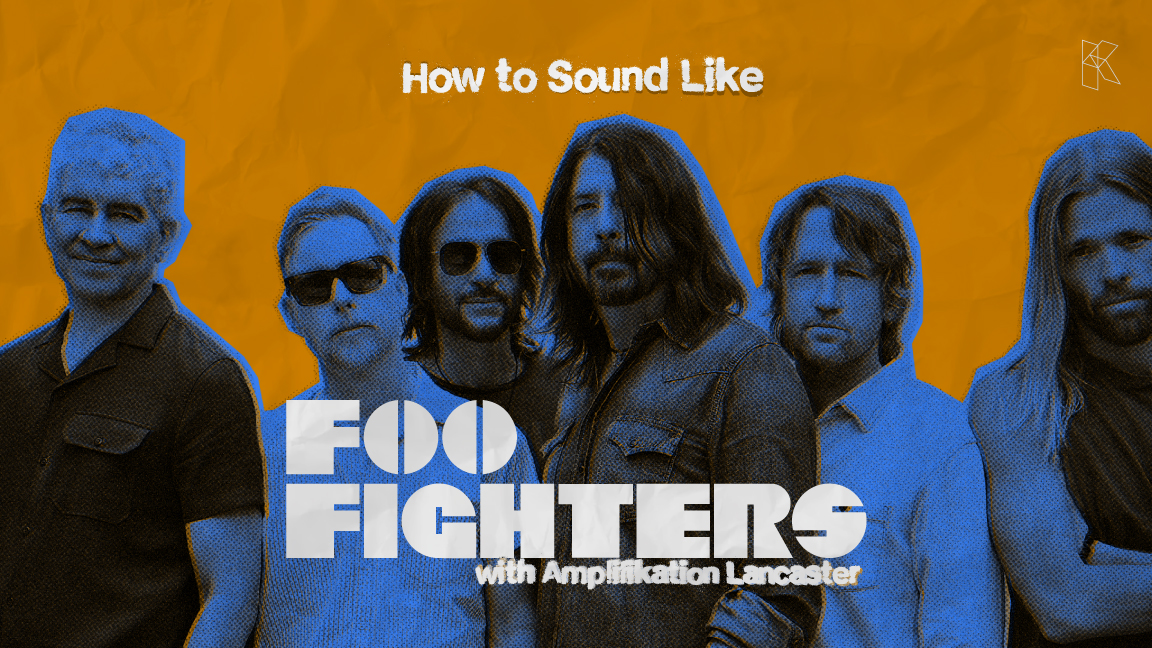The PretenderFoo Fighters
In the beginning of the 90’s, the world was fascinated by the recently famous rock band Nirvana. And this wasn’t surprising. The grunge movement, alternative rock combined with easy to remember pleasant melodies made a whole generation follow the wave. And yet the hysteria didn’t last long. In 1994 the singer Kurt Cobain died and Nirvana was disbanded.
Fans at that time had no idea that the future bright musical talent would lie ahead to emerge. Right about the next year after the ‘mainstream’ breakthrough, Nirvana’s drummer Dave Grohl started his one-man project where he played everything: guitar, drums, bass; and that was the beginning of today’s one of the biggest rock bands Foo Fighters.
We heard many favorite songs through the years from the Foos and some of you may be wondering why they’ve always sounded so bright and tight and natural? Well, the quintessential sound of Dave invariably has come from The Vox AC30.
Vox Amplifiers
Like all the cool amplifiers this was produced in an old school way. Back in 1956 a prototype guitar amp was introduced to the founder Thomas Jennings by a guitar player of a well known big band and workmate to him. This one became the starting point of subsequent amplifiers. Back then the name of the company was JMI-Jennings Musical Industries and the name VOX came up to him from the translation of the latin word VOICE. The very famous rock group at that time The Shadows were the first to trust him with his VOX AC15 and soon after that , they presented it to the public. Under the request of The Shadows and from the necessity of high end sound and louder amp, the creation of Vox AC 30 was inevitable.
It should be noted that exactly that very amplifier is a part of the cultural phenomenon British Invasion formed in the mid- sixties and flooded the world with The Beatles, The Rolling Stones and many more. Later AC30 would enchant such people as Brian May of Queen, Mark Knopfler, Ritchie Blackmore and so on.
Back to Foo Fighters and the guitar tone
But let’s return to Dave Grohl’s contribution to the glory of this amplifier. The main recipe of Dave’s guitar sound has always been not to use too many guitar pedals and find an amp that has a lot of range for tweaking. Clean, dirty and bright.The amp just delivers!
More than two decades we had the opportunity to enjoy the wonderful discography of the band, but we will pay special attention to the most successful song “The Pretender”.
The guitar part of that song feels dense and full in the mix. You can sense the power while at the same time there is that space that balances with all the other instruments.
Amplifikation Lancaster Amp Simulation
Kuassa couldn’t stay far from this 60 years successful legacy of those exceptional amplifiers that gave us inspiration to create a product software Lancaster amp sim which combines 3th generation modeling technologies with dynamic natural sounding of the real amp. You can tweak between A-2000’s, B-90’s and C-70’s types that represent absolutely different amplifiers, but combined together. Throughout those amps you will certainly find your preferable sound. We use seven well proven mics that will give you a realistic feeling, as well as five types of speaker cabinets. Sag and Bias are present again as always.
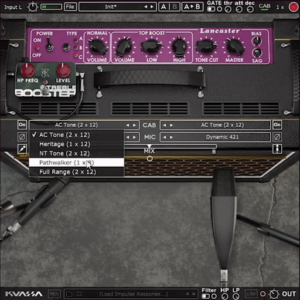
https://www.kuassa.com/products/amplifikation-lancaster/
NEW! Parallel signal path for the Normal Channel and Top Boost Channel. Use both channels simultaneously, similar to ‘jumpered’ Vox*
- 3 amp types, taken from different eras of Vox* AC30s:
- Lancaster A: Late 2000’s AC30. Breaks up and overdrives early. Raw and raucous.
- Lancaster B: 1990s Limited Edition AC30. Fat and slightly compressed. Sounds thick with overdrive or distortion.
- Lancaster C: Modified 1970s AC30. Cleaner sound with huge headroom, instantly recognizable for that loud jangly tone.
- Sag and Bias feature on the power amp section.
- Low pass and high pass filters.
- Five types of cabinets with impulse responses taken from genuine Vox combo amps.
- Seven types of workhorse mics: Shure* SM57, Sennheiser* MD421, Sennheiser* MD441, C&T Naked Eye*, Royer* 121, AKG* C414, Neumann*
*Disclaimer :
All trademarks are the property of their respective owners which are in no way associated or affiliated with Kuassa. The manufacturer names and model designations are used solely to identify the products whose tonal and sound characteristics were studied during development.
Recreating the tone with Amplifikation Lancaster in our Amplifikation 360 suite.
– Intro Clean Tone –
The song starts with a quite honest and clean guitar tone, the guitar qualities are presented by the amp and you can clearly hear how natural it sounds. It’s a sound in the face with a little reverb,the arpeggiated chords are intimate, placed in the middle of the stereo picture. It’s a guitar tone that is close to a real life situation, the natural feeling of an amp and a guitarist, playing the riff to tell the beginning of a story.
Dave is known for his love of vintage gear and he prefers recording with analog equipment, playing and recording with a few takes of the whole band. The signal chain of the guitar is simple. We will use just a compressor, the Lancaster C amp and a little bit of reverb.
The compressor is used to give more presence of the notes.

We will mix the Normal and the Top Boost channels for the clean part.
The Norm Channel adds a little low end and supports the bright tone of the Top Boost one.
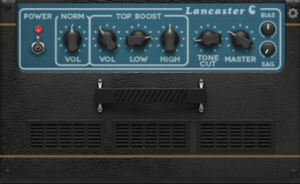
The reverb is just for ambience
Here you can hear the intro clean guitar alone
Audio Sample:
https://drive.google.com/file/d/1EOtNlEb5zD1ERgBEc-CSCdFg_09THZ4j/view?usp=sharing
– The Additional Guitar Riff –
Then a drum riff is punched in and there is a quite distinctive guitar riff played on one string that seems to be doubled with the old Haas trick using two delays to give the listener the experience of that wide stereo artificial effect.
It’s a little complicated one. To achieve the Haas Stereo Trick, two amps are fed through two delays and then two EQ to shape the tone further.
The distortion is coming from our Efektor Distortion combined with the saturation of the amps.

Using the container to have left and right signals then two delays after the amp panned with the Stereo Panner module.
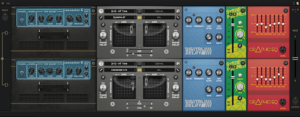
The container is set to parallel to have to independent signal paths

Here you can hear the haas stereo guitar alone
Audio Sample:
https://drive.google.com/file/d/11LAXicnK0fJ02uwejmjXY7844iAp6wbe/view?usp=sharing
The rhythm guitar
When the two rhythm guitars are entering the arrangement they are cutting through with quite a mid range tone and they support the vocal line with a solid background.
For the Rhythm guitar parts a distortion pedal is combined with the top boost channel of the amp.

It pushes the amp preamp stage for more distortion and shaping the overall character of the tone stack.
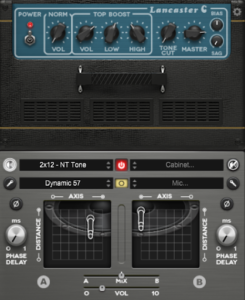
The Cab is 2×12 NT Tone mic’d with the classic 57
Here you can hear the rhythm guitars alone
Audio Sample:
https://drive.google.com/file/d/1l5ozuKo9nEmjaMGTMrhq68RB30iMinXM/view?usp=sharing
Here you can hear the whole mix
Audio Sample:
https://drive.google.com/file/d/147If4xF9nS7K-vpV2mrdJJgkwseC0aX8/view?usp=sharing
Here you can download the preset and copy it to your presets folder:
Link:
https://drive.google.com/file/d/1uuSH2kA_QQnQ5frDzsS5mUSzv5slhIzN/view?usp=sharing
The preset file for A360 looks like this: Foo The Pretender.ka360p copy the file after extracting from the zip file at:
Presets folder:
Windows:
C:\Users\[User Name]\Documents\Kuassa\Presets\Amplifikation360
Mac:
/Users/[User Name]/Music/Kuassa/Presets/Amplifikation360
Whether you are a beginner or professional guitarist, when you turn on your Lancaster amp simulator you will want to start creating your future masterpiece right away. A true classic with pure tone!
Stay tuned for more tones in the next weeks with history, explanation and preset for download!


